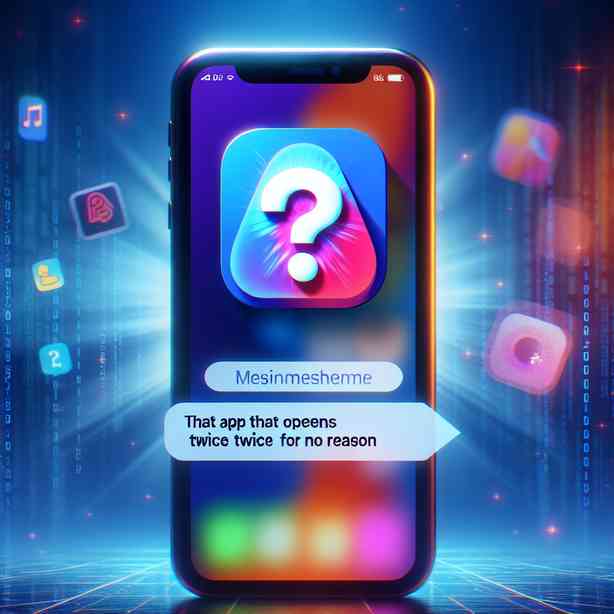
There are instances when technology, particularly applications on our devices, behaves in unexpected ways. One common issue that many users encounter is when an app opens twice, seemingly without reason. This odd phenomenon can be a source of frustration and confusion. In this article, we will delve into the potential reasons behind this peculiar behavior, explore its implications, and provide solutions to rectify the issue.
First and foremost, the basic understanding of how applications function on devices is crucial. When you tap on an app icon, a command is sent to the operating system to launch the application. Ideally, the OS executes this command and the app opens seamlessly. However, if you notice that an app opens twice, it may stem from various underlying causes worth exploring.
One possibility is a glitch within the app itself. Many applications undergo constant updates to improve performance, fix bugs, and enhance user experience. During these updates, unforeseen issues may arise, leading to erratic behavior, such as the app launching multiple instances when only one is requested. This can happen if the app was not coded properly or if the update introduced a conflict with existing functionality. If you suspect that a particular app is misbehaving, checking for updates or reinstalling the app might help resolve the issue.
Another potential explanation could be related to the device’s operating system. Different OS architectures handle application processes differently. For instance, Android and iOS manage apps in unique ways, and occasional bugs may cause them to misinterpret commands. In certain cases, the operating system may mistakenly duplicate the launch request due to background processes, leading to the application appearing twice. Regular updates to your device’s OS can mitigate these issues, so ensuring you’re running the latest version of your operating system is always advisable.
Additionally, the interaction between various applications could also lead to this behavior. If two applications are poorly optimized or interacting in ways that generate conflicts, it may result in one or both of them behaving unexpectedly. A classic example of this is when you have multiple applications that require similar system resources or permissions. Such conflicts can cause an app to spawn additional instances inadvertently, which can be resolved through careful app management and resource allocation.
Device memory could also play a significant role in this situation. Insufficient RAM or storage space can lead to performance issues, causing apps to misbehave. When an app runs, it requires memory to execute its functions. If your device is low on resources, it might struggle to manage application launches efficiently, leading to duplicate openings. Regularly cleaning up unused apps, files, and ensuring adequate storage space can help keep the device’s performance smooth and mitigate issues related to app management.
On the user side, there might also be habits that inadvertently result in the app opening twice. For instance, users may double-tap the app icon due to impatience or an impulse when an app takes too long to load, which can lead to two processes being initiated simultaneously. Furthermore, gestures or touch sensitivity settings on certain devices may mistakenly register multiple taps when only one is intended. Being mindful of how you interact with your device can therefore prevent such occurrences.
Next, ensuring that there are no rogue software issues is essential. Occasionally, malware or unauthorized applications can interfere with how legitimate apps function on your device. They can create unexpected behaviors, including duplicating app launches. Running a comprehensive antivirus scan or using trusted security software can help identify and eliminate threats that may cause such issues.
If you continue to experience the problem after examining all these aspects, consider reaching out to the application’s support team. They may have encountered similar issues with other users and can provide tailored solutions or workarounds specific to that application. Moreover, user feedback is often invaluable for developers, as it can guide future updates to enhance performance and resolve existing bugs.
In summary, while an application inexplicably opening twice can be frustrating, it is often a solvable problem. By examining app updates, the operating system, potential conflicts between applications, device memory, user habits, and even security threats, users can pinpoint the cause of this annoyance. Cultivating an understanding of how these elements interact can empower users to address issues effectively, leading to a smoother app experience.
Given the complexities of today’s smartphones and technology, encountering unexpected behaviors within applications is more common than one might think. However, through a combination of proactive maintenance, user awareness, and seeking assistance when needed, you can greatly reduce these occurrences and enjoy a more seamless interaction with your devices. By investing time in understanding the underlying factors contributing to unexpected app behavior, you can navigate these technological quirks more effectively, ensuring that your experience remains positive and productive.
Ultimately, technology is designed to improve our lives, streamline processes, and enhance our productivity. By staying informed and engaged with how our devices work, we can harness their capabilities to their fullest potential. Always remember that while technology can sometimes falter, a little knowledge and patience go a long way in troubleshooting and achieving a satisfying user experience.


